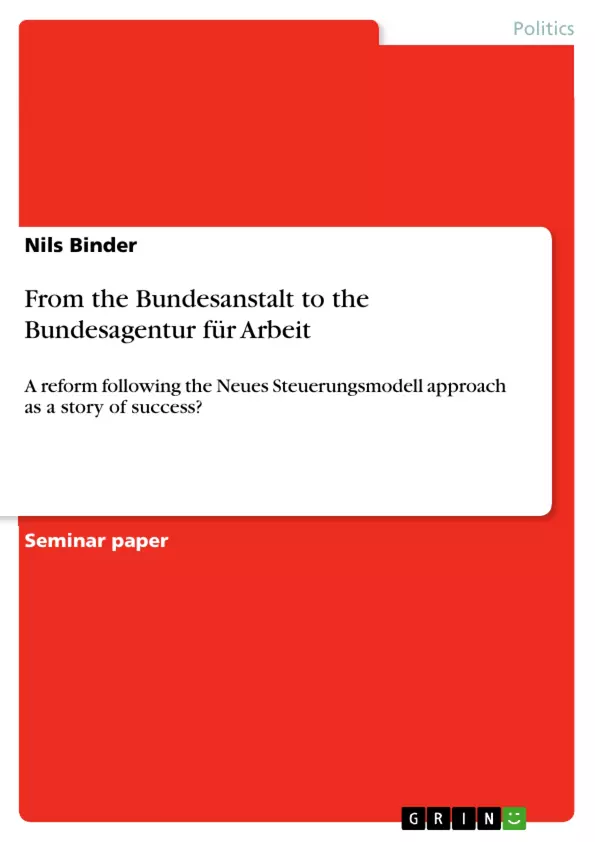Bureaucracy […] is slow, inept, and wasteful. Striking the prescriptive literature is the degree that this stereotype is simply accepted without any empirical evi-dence […] (Meier/Hill 2005: 52).
This citation represents – although heavily questioned in the Oxford Handbook of Pub-lic Management – a widespread opinion that the classical bureaucracy model is not able to meet modern administration challenges effectively. This is the reason, why the New Public Management (NPM) was welcomed as a new concept for modern administration.
But at the beginning, the New Public Management (NPM) approach was looked at very skeptically and critically in Germany. The introduction of management and business administration elements, developed in the Anglo-Saxon countries, as new concept to improve efficiency in the public administration was considered unnecessary at best due to the fact that the German public administration was certified to have a relatively high performance in comparison to other western countries. Maybe because of this the Ger-man interpretation of the NPM approach was introduced very late, later than in most other western European countries. The result of this German NPM version is the Neues Steuerungsmodell (NSM) (Jann 2005: 76).
The NSM is the German interpretation of the NPM approach with significant similarities but some differences. Whereas the NPM is often connected with liberalization tendencies in the Anglo-American region with the aim of smaller administrations (Mei-er/Hill 2005: 55), the NSM was introduced in communal, regional and federal administrations to improve effectiveness and efficiency but not necessarily with reducing the size of an administration department.
One perfect example for the implementation of the NSM in an authority is the reform of the Bundesanstalt für Arbeit (BA) as part of the Hartz legislation in the second Schröder election period from 2002 till 2005. The BA is as one of the biggest social policy institutions responsible for all employment market issues such as job service and placement, transfer payments and vocational training and its reforms were clearly related to the NSM approach as this paper will show.
Several strategies for modernization in the public sector are subsumed under the NSM concept without distinguishing between completely new strategies and approaches and old reform ideas that are just brought up again.
Table of Contents
- Introduction.
- The Neues Steuerungsmodell
- Origin and relation/differences to the New Public Management approach
- Concept of the NSM approach.
- Decentralizing and changes in the organizational culture.
- Output oriented governance and budget transparency
- Human resources management and development.
- Changes in the relation between politics and administration
- Changes in the relations to the outside world.
- The NSM in the Bundesagentur für Arbeit.
- Implementation of the NSM approach.
- Recommended course of action according to the evaluation report.
- Conclusion and discussion.
Objectives and Key Themes
This paper aims to examine the reform of the Bundesanstalt für Arbeit (BA) as part of the Hartz legislation, analyzing whether it successfully implemented the Neues Steuerungsmodell (NSM) approach. The study explores the origins and main aspects of the NSM, its implementation in the BA, and evaluates the effectiveness and efficiency of the reforms.
- The origins and main aspects of the Neues Steuerungsmodell (NSM).
- The implementation of the NSM in the Bundesagentur für Arbeit (BA) through the Hartz legislation.
- The evaluation of the reform's success in terms of effectiveness, efficiency, and other relevant criteria.
- The comparison of the NSM with the New Public Management (NPM) approach.
- The role of decentralization, output-oriented governance, and human resource management in the NSM approach.
Chapter Summaries
- Introduction: This chapter introduces the concept of the New Public Management (NPM) and its evolution, highlighting the limitations of the traditional bureaucracy model and the emergence of the NPM as a response to modern administration challenges. The chapter introduces the Neues Steuerungsmodell (NSM) as the German interpretation of the NPM, focusing on its similarities and differences. The paper focuses on the reform of the Bundesanstalt für Arbeit (BA) as an example of NSM implementation.
- The Neues Steuerungsmodell: This chapter delves into the origins and core principles of the NSM approach, outlining its relation to the New Public Management (NPM) and exploring its key elements, including decentralization, output-oriented governance, and human resource management. The chapter discusses the NSM's focus on efficiency and effectiveness improvements in public administration.
- The NSM in the Bundesagentur für Arbeit: This chapter examines the implementation of the NSM in the BA, analyzing the specific reform steps taken and the recommendations presented in the evaluation report. This chapter focuses on the changes in the organizational structure, financial resources, and human resource management within the BA.
Keywords
The main keywords and focus topics of this study are: New Public Management (NPM), Neues Steuerungsmodell (NSM), public administration reform, decentralization, output-oriented governance, human resource management, Bundesanstalt für Arbeit (BA), Hartz legislation, efficiency, effectiveness, evaluation.
- Quote paper
- Nils Binder (Author), 2011, From the Bundesanstalt to the Bundesagentur für Arbeit, Munich, GRIN Verlag, https://www.grin.com/document/208397



